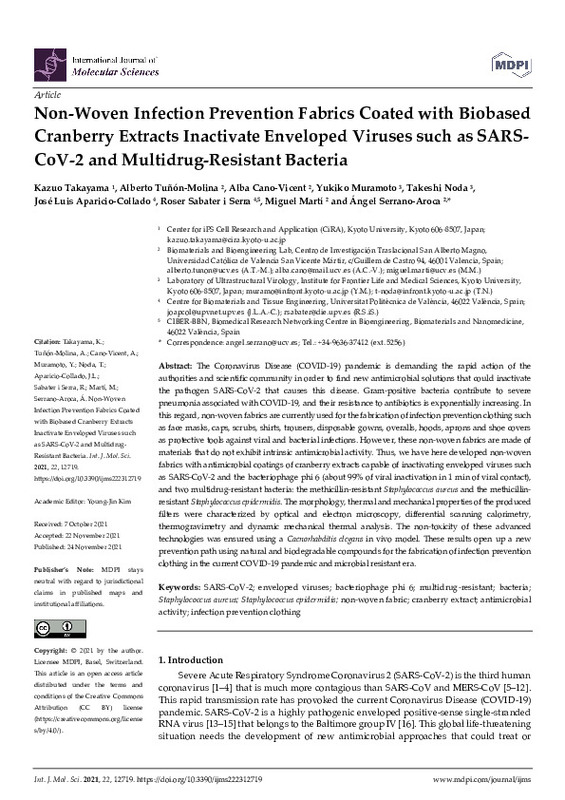JavaScript is disabled for your browser. Some features of this site may not work without it.
Buscar en RiuNet
Listar
Mi cuenta
Estadísticas
Ayuda RiuNet
Admin. UPV
Non-Woven Infection Prevention Fabrics Coated with Biobased Cranberry Extracts Inactivate Enveloped Viruses Such as SARS-CoV-2 and Multidrug-Resistant Bacteria
Mostrar el registro sencillo del ítem
Ficheros en el ítem
| dc.contributor.author | Takayama, Kazuo
|
es_ES |
| dc.contributor.author | Tuñón-Molina, Alberto
|
es_ES |
| dc.contributor.author | Cano-Vicent, Alba
|
es_ES |
| dc.contributor.author | Muramoto, Yukiko
|
es_ES |
| dc.contributor.author | Noda, Takeshi
|
es_ES |
| dc.contributor.author | Aparicio-Collado, José Luís
|
es_ES |
| dc.contributor.author | Sabater i Serra, Roser
|
es_ES |
| dc.contributor.author | Martí, Miguel
|
es_ES |
| dc.contributor.author | Serrano-Aroca, Ángel
|
es_ES |
| dc.date.accessioned | 2022-09-27T18:04:09Z | |
| dc.date.available | 2022-09-27T18:04:09Z | |
| dc.date.issued | 2021-12 | es_ES |
| dc.identifier.uri | http://hdl.handle.net/10251/186634 | |
| dc.description.abstract | [EN] The Coronavirus Disease (COVID-19) pandemic is demanding the rapid action of the authorities and scientific community in order to find new antimicrobial solutions that could inactivate the pathogen SARS-CoV-2 that causes this disease. Gram-positive bacteria contribute to severe pneumonia associated with COVID-19, and their resistance to antibiotics is exponentially increasing. In this regard, non-woven fabrics are currently used for the fabrication of infection prevention clothing such as face masks, caps, scrubs, shirts, trousers, disposable gowns, overalls, hoods, aprons and shoe covers as protective tools against viral and bacterial infections. However, these non-woven fabrics are made of materials that do not exhibit intrinsic antimicrobial activity. Thus, we have here developed non-woven fabrics with antimicrobial coatings of cranberry extracts capable of inactivating enveloped viruses such as SARS-CoV-2 and the bacteriophage phi 6 (about 99% of viral inactivation in 1 min of viral contact), and two multidrug-resistant bacteria: the methicillin-resistant Staphylococcus aureus and the methicillin-resistant Staphylococcus epidermidis. The morphology, thermal and mechanical properties of the produced filters were characterized by optical and electron microscopy, differential scanning calorimetry, thermogravimetry and dynamic mechanical thermal analysis. The non-toxicity of these advanced technologies was ensured using a Caenorhabditis elegans in vivo model. These results open up a new prevention path using natural and biodegradable compounds for the fabrication of infection prevention clothing in the current COVID-19 pandemic and microbial resistant era. | es_ES |
| dc.description.sponsorship | This research was supported by the Fundacion Universidad Catolica de Valencia San VicenteMartir, Grant 2020-231-006UCV and by the Ministerio de Ciencia e Innovacion: project PID2020-119333RB-I00/AEI/10.13039/501100011033 (awarded to A.S.-A.) and project RTI2018-097862-B-C21 (awarded to R.S.i.S. including FEDER funding). CIBER-BBN is an initiative funded by the VI National R&D&I Plan 2008-2011, Iniciativa Ingenio 2010, Consolider Program. CIBER Actions are financed by the Instituto de Salud Carlos III with assistance from the European Regional Development Fund. This research was also supported by grants from the Japan Agency for Medical Research and Development (AMED) (20fk0108533h0001), and the JST Core Research for Evolutional Science and Technology (JPMJCR20HA). This work was supported by the Joint Usage/Research Center program of Institute for Frontier Life and Medical Sciences Kyoto University. | es_ES |
| dc.language | Inglés | es_ES |
| dc.publisher | MDPI AG | es_ES |
| dc.relation.ispartof | International Journal of Molecular Sciences | es_ES |
| dc.rights | Reconocimiento (by) | es_ES |
| dc.subject | SARS-CoV-2 | es_ES |
| dc.subject | Enveloped viruses | es_ES |
| dc.subject | Bacteriophage phi 6 | es_ES |
| dc.subject | Multidrug-resistant | es_ES |
| dc.subject | Bacteria | es_ES |
| dc.subject | Staphylococcus aureus | es_ES |
| dc.subject | Staphylococcus epidermidis | es_ES |
| dc.subject | Non-woven fabric | es_ES |
| dc.subject | Cranberry extract | es_ES |
| dc.subject | Antimicrobial activity | es_ES |
| dc.subject | Infection prevention clothing | es_ES |
| dc.subject.classification | INGENIERIA ELECTRICA | es_ES |
| dc.title | Non-Woven Infection Prevention Fabrics Coated with Biobased Cranberry Extracts Inactivate Enveloped Viruses Such as SARS-CoV-2 and Multidrug-Resistant Bacteria | es_ES |
| dc.type | Artículo | es_ES |
| dc.identifier.doi | 10.3390/ijms222312719 | es_ES |
| dc.relation.projectID | info:eu-repo/grantAgreement/AEI/Plan Estatal de Investigación Científica y Técnica y de Innovación 2017-2020/PID2020-119333RB-I00/ES/SOPORTES BIOFUNCIONALES CON CAPACIDAD OSTEOINDUCTORA Y ANTIMICROBIANA PARA INGENIERIA TISULAR OSEA/ | es_ES |
| dc.relation.projectID | info:eu-repo/grantAgreement/UCV//2020-231-006UCV/ | es_ES |
| dc.relation.projectID | info:eu-repo/grantAgreement/AMED//20fk0108533h0001/ | es_ES |
| dc.relation.projectID | info:eu-repo/grantAgreement/AEI/Plan Estatal de Investigación Científica y Técnica y de Innovación 2017-2020/RTI2018-097862-B-C21/ES/MICROENTORNOS BIOACTIVOS, ELECTROCONDUCTIVOS Y ANTIMICROBIANOS CON CAPACIDAD DE ESTIMULAR LA REGENERACION OSEA Y PREVENIR INFECCIONES MULTIRRESISTENTES/ | es_ES |
| dc.relation.projectID | info:eu-repo/grantAgreement/JST//JPMJCR20HA/ | es_ES |
| dc.rights.accessRights | Abierto | es_ES |
| dc.contributor.affiliation | Universitat Politècnica de València. Departamento de Ingeniería Eléctrica - Departament d'Enginyeria Elèctrica | es_ES |
| dc.description.bibliographicCitation | Takayama, K.; Tuñón-Molina, A.; Cano-Vicent, A.; Muramoto, Y.; Noda, T.; Aparicio-Collado, JL.; Sabater I Serra, R.... (2021). Non-Woven Infection Prevention Fabrics Coated with Biobased Cranberry Extracts Inactivate Enveloped Viruses Such as SARS-CoV-2 and Multidrug-Resistant Bacteria. International Journal of Molecular Sciences. 22(23):1-17. https://doi.org/10.3390/ijms222312719 | es_ES |
| dc.description.accrualMethod | S | es_ES |
| dc.relation.publisherversion | https://doi.org/10.3390/ijms222312719 | es_ES |
| dc.description.upvformatpinicio | 1 | es_ES |
| dc.description.upvformatpfin | 17 | es_ES |
| dc.type.version | info:eu-repo/semantics/publishedVersion | es_ES |
| dc.description.volume | 22 | es_ES |
| dc.description.issue | 23 | es_ES |
| dc.identifier.eissn | 1422-0067 | es_ES |
| dc.identifier.pmid | 34884521 | es_ES |
| dc.identifier.pmcid | PMC8657951 | es_ES |
| dc.relation.pasarela | S\453469 | es_ES |
| dc.contributor.funder | Instituto de Salud Carlos III | es_ES |
| dc.contributor.funder | Agencia Estatal de Investigación | es_ES |
| dc.contributor.funder | European Regional Development Fund | es_ES |
| dc.contributor.funder | Japan Science and Technology Agency | es_ES |
| dc.contributor.funder | Ministerio de Ciencia e Innovación | es_ES |
| dc.contributor.funder | Japan Agency for Medical Research and Development | es_ES |
| dc.contributor.funder | Universidad Católica de Valencia San Vicente Mártir | es_ES |








